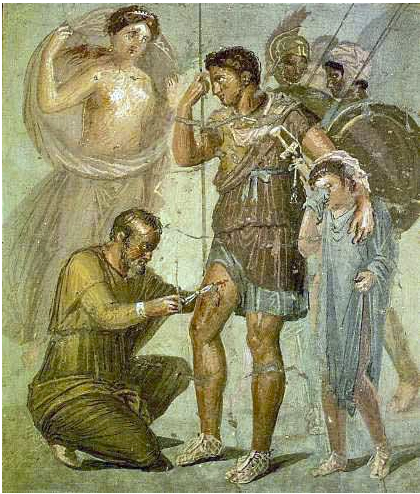
- Articles
Another medical journey to ancient Rome and Roman medicine with medical historian Plinio Prioreschi, MD, PhD
This is the third volume of the monumental A History of Medicine series by the medical historian and classical scholar Plinio Prioreschi M.D., PhD.[1] A limited number of these books were published, and the reader would be fortunate to find copies of the tomes for less than $350 U.S. dollars. We have already reviewed Volume I: Primitive and Ancient Medicine (2nd edition, 1995) and Volume II: Greek Medicine (2nd edition, 1996).[2,3] We found both of these tomes to be excellent journeys to the history of medicine (and indirectly medical ethics). This third volume continues the well‑researched scholarly tradition as well as hypnotic eloquence of Dr. Plinio Prioreschi’s narrative.
Once again, it is worth repeating that Dr. Prioreschi does not hesitate to deviate from orthodox or dogmatic views when new facts have come to light, when previous information has been neglected or misinterpreted, or when logical reasoning calls for a new interpretation of the facts. He does the same in this, the heftiest of the first three volumes — if one includes his Foreword, Introduction, and Index — at over 800 pages.
By 268 B.C., Rome was the eternal city, the caput mundi and mistress of the Mediterranean. By 167 B.C., Macedonia had been conquered and the Greek city states, at first freed, were finally vanquished because of their political mischief and internecine warfare. Nevertheless as Horace asserted, “Conquered Greece conquered the fierce victors,” as Greek culture gained ascendency in the Roman world.

In the first three chapters of Roman Medicine, Prioreschi discusses the history, religion, science, and technology of ancient Rome. One of the cultural aspects of ancient Rome was widespread slavery ever augmented by captured war prisoners as Rome spread over the Mediterranean region. With such manpower, there was no need for scientific discoveries and technological advances. Another interesting finding and discussion is that male homosexuality in ancient Rome was less tolerated than in Greece. Once again it should be noted that, as in Greece, the Roman concept of homosexuality is different from the Anglo‑Saxon and northern European.
Pederasty was accepted but with young male slaves only. The active partner, the penetrator, was the macho, virile element; the passive partner was considered the submissive homosexual partner and shamed in the act. Homosexual relations, wrote Prioreschi, “between adults was considered and abomination (for the passive partner) and were also illegal in the Roman world.” Most Romans, including the poets and philosophers, condemned the practice. The Roman physicians Soranus and Caelius Aurelianus considered male homosexuality a mental disorder.[4] Lesbianism was not discussed.
When Rome conquered Greece, Greek aesthetics and philosophy proved irresistible even though the Hellenic influence was perceived by most learned Romans as weakening traditional values. The Greeks themselves were considered vitiorum omnium genitores, “the originators of all vices.” Romans like Cicero (106–43 B.C.), as well as Romanized Greeks such as Diodorus Siculus (1st century B.C.), Posidonius (135–51 B.C.), and Polybius (c. 200–118 B.C.) are quoted as supporting traditional religion because it bolstered the social morality that seemed to be dissolving by Greek aesthetic ideas and mores.[5] Nevertheless, all Greek philosophies entered Roman culture, but the most influential thinker was the stoic philosopher Posidonius (1st century B.C.), who taught at Rhodes and influenced the great orator Cicero. Their writings in turn influenced the later stoic philosophers Seneca (died A.D. 65) and Marcus Aurelius (r. A.D. 161–180).
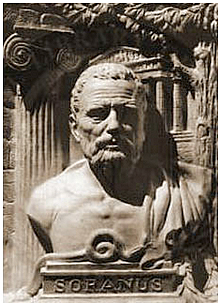
In Chapter IV, “Medicine Before Galen,” we learn Roman medicine is essentially Greek medicine as practiced in the Roman Empire.[6] Many of the Roman physicians were actually Greek slaves who became famous, wealthy, and free. Among the great names in Roman medicine and their schools of thought in this period include the physician Asclepiades (1st century B.C.), who probably performed the first tracheostomy and developed his own physiology based on the flow of fluids between solid particles of the body (atoms) through constricting and relaxing (strictum et laxum) “pores.” This theory as well as the quest for a middle ground between the Dogmatist and the Empiricist schools resulted in the Methodist school of medical thought.[2] Other notable physicians of this period include the Methodist Soranus of Ephesus (1st to 2nd century A.D.; photo, left), the greatest gynecologist of antiquity; Scribonius Largus (1st century A.D.), pharmacologist, medical ethicist, and physician to the Roman Emperor Claudius (r. A.D. 41–54); the great patrician physician Celsus (early 1st century A.D.); the Roman encyclopedists (and probably pater familiae physicians), Varro (116–27 B.C.), Vitruvius (1st century B.C.), and Pliny the Elder (A.D. 23–79); the botanist and pharmacologist Dioscorides (1st century A.D.); and the able and eclectic Rufus of Ephesus (1st to 2nd century A.D.), who revived the concept of perittoma of Aristotle and Hippocrates discussed in Volume II, Greek Medicine.[3]
We should single out for praise the encyclopedist and polymath Celsus, who was a remarkable Roman aristocrat, a great anatomist, and the most knowledgeable and adept physician and surgeon until Galen. Celsus wrote the first major medical treatise in Latin and his description of surgical lithotomy was unsurpassed until modern times. He described succinctly the classical signs of inflammation: Rubor, tumor, calor, dolor (i.e., redness, swelling, heat and pain) that medical students are still taught today.[6]
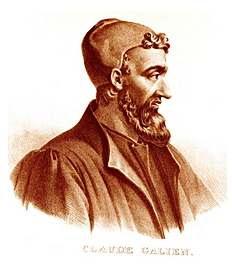
Chapter V brings to the fore the greatest physician of antiquity after Hippocrates. Galen (A.D. 129–200; photo, left) was born in Pergamon (or Pergamum), where he began as physician and surgeon to the gladiators and ended in Rome as physician and surgeon to Emperors Marcus Aurelius, Commodus, Pertinax and Septimius Severus. Prioreschi does not like Galen, the man; but he admired Galen, the physician, who he nevertheless affirms “is only second to Hippocrates in the medical hagiography of the Western world.”[7]
In Chapter V, Prioreschi discusses Galenic medicine, which makes fascinating and obligatory reading for a medical historian: “Rome created the milieu for the Golden Age from the 1st century B.C. to the 1st century A.D., and in medicine the burst of ferment and creativity culminated with Galen,” who continued medical theory and practice in the tradition of Hippocratic medicine. But Galen not only expanded the humoral theory, performed anatomical studies, experiments, but on this foundation he also erected an edifice of medical knowledge.[8]
Galen, although classified as a Dogmatist (traditional school of thought founded by the followers of Hippocrates), believed that both reason (logos) and experience (empeiria) were useful in the attainment of knowledge. Galen accepted the theories of Empedocles, Plato, and Aristotle in medical theory, but did not hesitate to criticize any of his illustrious predecessors when he believed they were incorrect. In fact, Galen, writes Prioreschi, was acrimonious and polemical, traits he may have inherited from his mother, “a Xanthippe” type of woman in the mold of Socrates’ notoriously quarrelsome wife of that name. For Galen, only Hippocrates was infallible. Even Aristotle supposedly “made mistakes [in anatomy] because he was not an experienced dissector.” Galen also rejected the atomic theory of Democritus and its outgrowth, Methodism, which attempted to oversimplify medical theory and practice. He also dismissed the atomistic paradigm of the Epicureans as false and erroneous. Galen wrote the first and most comprehensive manual of anatomy to have survived from antiquity, De anatomicis, a large body of knowledge based on the systematic dissection of barbary apes, oxen, and pigs.[8]
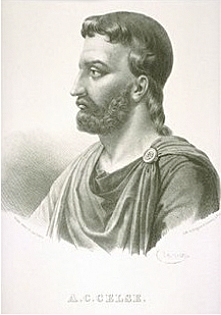
Galen discovered the sources of paraplegia, quadriplegia, and hemiplegia based on animal studies. Erasistratus’ explanation that arteries contained air (pneuma) but only seem to bleed because of the phenomenon of horror vacui, Galen asserted was also incorrect. Arteries contained blood (and pneuma mixed with it) explained Galen. The ventricles of the heart contain blood that was ejected to the body. But Galen also made errors; although he proved that the ventricles contain blood, there was no interventricular mixing of blood via hidden foramina; and the rete mirabilis he described in lower animals did not exist in humans as he asserted.[8] Amazingly Galen also subscribed to the efficacy of theriac, a poison antidote made of dozens of ingredients, which was developed as a result of the interest of Attalus, king of Pergamon, with herbal poisons; and the efforts of Mithridates VI, king of Pontus (134–63 B.C.), in developing a universal antidote against assassination by poisoning. Theriac presented an enterprising apothecary with a challenge, not only to concoct but also procure vipers’ flesh and other wild and esoteric ingredients. It is of interest that Aulus Cornelius Celsus (photo, left), as well as Pliny the Elder, had noted that snake venoms were not effective when taken orally and that viper flesh could be eaten safely.[6]
Galen’s evaluation of ascites and other clinical conditions were unsurpassed until after the Renaissance. And the incredible diagnosis, anatomical explanation, clinical course, and prognosis of a fellow physician with mitral stenosis is an outstanding example of his clinical acumen.[9]
The great physician from Pergamon was hampered in the discovery of the circulation of blood probably because he would not overstep Hippocrates’ theory of “the irrigating fields and consumption of blood in the periphery,” as discussed in our previous reviews of Volumes I and II of Prioreschi’s A History of Medicine.[2,3] Galen came even closer to the discovery of the lesser pulmonary circulation, but he would not take the critical step. This impediment in the advancement of medicine because of previous erroneous assertions has been undeservedly termed the damnosa hereditas.[10] On the other hand, Galen wisely restrained the surgical predilection of the Hippocratic surgeons for cranial trephination as treatment for head injuries, and he condemned the widespread practice of dreckapotheke[2,3] as abominable, disgusting, and ineffective.[8]
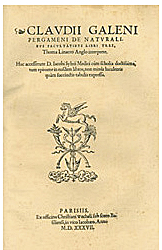
The fact is that Galen’s contribution to medical knowledge is impressive. Moreover, this contribution included anatomical studies (mostly in animals, as human dissection had fallen again out of favor since Herophilus and Erasistratus 400 years earlier) as well as advocating experimentation, testing, and observation. It was unfortunate his successors did not continue his work in the advancement of the scientific method via experimentation. Galen left 20 volumes of Galenic medicine (i.e., Claudii Galenic opera omnia; photo, left) of which two‑thirds are extant. With Galen’s ministrations, medicine and surgery reached a zenith in the Roman world. Galenic medicine was deemed authoritative in both Christendom and the Islamic nations during the Middle Age, and remained so until the advent of the scientific revolution in anatomy instituted by Andreas Vesalius during the Renaissance.
Chapter VI discusses Roman medicine after Galen.[11] The main physicians during this period are Oribasius (A.D. c. 320–400), physician to the Emperors Julian the Apostate (r. A.D. 361–363) and Valens (A.D. c. 328–378); and Caelius Aurelianus (2nd century A.D.), who translated into Latin and paraphrased Soranus (c. 98–138). During this period, medicine and surgery rapidly regressed and deteriorated into the widespread use of dreckapotheke, ineffective herb potions, magic, and an obscurantism that coincided with the instability, uncertainty, and political and military decline of Rome. Prioreschi likens this period in which “the capacity of man to understand nature was rejected” and “the value of science questioned” to postmodernism,[12] which he discusses in the Introduction to this volume.[13]
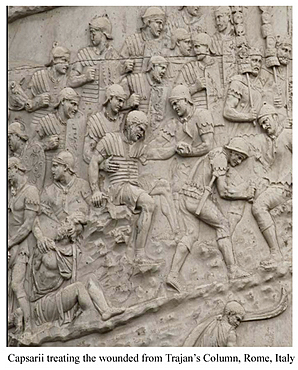
Chapter VII discusses Roman military medicine and is an exciting chapter. From the time of Julius Caesar, the legions contained military doctors medici ordinarius legiones to promptly and effectively treat the wounded near the battle field in specially erected medical tents. Later fortified valetudinaria of the camps were constructed as infirmaries and military hospitals. Many Latin inscriptions and medical texts survive referring to these military medici and medical orderlies, capsarii, so named because they carried receptacles for bandages and medications, perhaps even surgical instruments. Both Celsus and Galen taught how to ligate vessels to stop hemorrhage as well as treat slashing and penetrating wounds, and military medici probably did so.[14] Penetration of viscera were usually fatal because of infection and internal hemorrhage. Advances in Roman preventive medicine and public health with the advent of institutionalized sanitation and hygienic practices prevented epidemic diseases in the camps.
Commanders expected their soldiers to maintain high standards of cleanliness, physical fitness; and the constructed valetudinarii were built as rectangular forts in the Roman military manner with sanitary facilities, potable water, sometimes even spas (thermae) and gymnasia (palaestrae). Latrines were flushed continuously with water and the excreta collected and used as fertilizer. Led by the state of sanitation in the military, Prioreschi estimates the cleanliness of the Roman population could not be matched in Europe until the 19th century.[15]
One can realistically surmise that the Roman state of health and the military tradition was consistent with Juvenal’s shortened aphorism, quoted by Prioreschi mens sana in corpore sano — “Pray the gods for healthy minds in healthy bodies and for a stout heart that does not fear death.”[16]
Chapter VIII, “Physicians, Education, Ethics, Hospital, and Public Health” as noted by the title deals sequentially and succinctly with those issues.[17] We have already sporadically made statements attesting to those subjects and relating the place Roman physicians occupied in the Roman world in aforementioned discussions.

Chapter IX is entitled “Contraception and Abortion in the Greco‑Roman World,” and in this section Prioreschi deals with the timely subjects in an engaging manner. A few facts are of interest: Plagues may have been a factor in the declivity of the empire; there were no hallucinogenic drugs in the ancient Greco‑Roman world; Romans knew to boil water and the importance of cleanliness; most if not all abortifacients, as with the Greeks, were pharmacologically ineffective, although pessaries may have been effective as mechanical agents. It should also be noted disappointingly that there is no evidence poppy (opium) was used specifically and effectively as an analgesic or anesthetic. It was not used more frequently than other noneffective drugs for pain (suggesting nonspecificity) and the dosage and purity were too low to have an active principle (i.e., be effective as a pharmacological agent. In short, the benefits and efficacy of systemic abortifacients, analgesics, and the various herbs used systemically for a variety of conditions by the ancients (including the Roman physician) are exaggerated for their value or their purported efficacy. This error is due to “the mistaken general conception that the ancients possessed profound medical knowledge they did not really possess.”[18]
In Chapter X we shift the subject to Talmudic medicine.[19] The Talmud is the Jewish oral law with rabbinical commentaries as opposed to Scripture. Biblical medicine, supernaturalistic religious medicine based on God as healer, was discussed in Volume I.[2]
The naturalistic paradigm came about after the religious confidence of the Hebrews was shattered by the military conquests of Alexander the Great and the establishment of Hellenism in the Holy Land, followed by the shattering military victories and suppressions of the Roman legions. The social and religious crisis culminated with the destruction of the Temple in A.D. 70 and the Jewish Diaspora that permitted the new naturalistic paradigm of Talmudic medicine to take deeper roots, as opposed to the strict practice of supernaturalistic Biblical medicine. The acceptance of physicians by the Jews in Talmudic medicine and for Christians with the New Testament as part of God’s design also solved the dilemma of the supernaturalistic versus naturalistic approach to medicine and surgery for both Jews and Christians.[20,21]
Talmudic medicine is then naturalistic folk medicine, similar to Greco‑Roman itinerant medical practices with an abundance of demonology, evil eye beliefs, astrology, magic, and dreckapotheke. The Semitic practice of circumcision, Prioreschi posited, was related to removing superfluous evil parts from the body; another school of thought is that it developed from hygienic practices, similar to kosher food consumption. Talmudic medicine approves the administration of wine with frankincense or myrrh to benumb the senses prior to surgery, and commands that C‑sections be performed on all dead mothers.[19]
Chapter XI discusses Christianity, ancient science and medicine, and concludes by addressing the insoluble problems posed by the interface of Christian theology and medical philosophy. Religion faces a spiritual crisis when the supernaturalistic medical paradigm is perceived as unsatisfactory to explain a new world view following a political or military collapse, as happened with the fall of Rome in the 5th century A.D. and the advent of Christianity. Medicine after Galen, perhaps because of the influence of Christianity, devolved to philology and exegesis of medical texts replacing empirical research.[21]
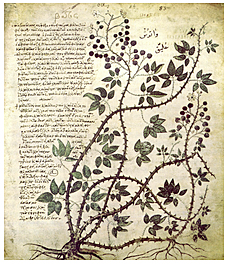
The final section, General Conclusions, summarizes pharmacopeia, the efficacy of herbs and other drugs, and the ancient common practice of “plagiarism.”[22] The pharmacopeia of Pliny, Theophrastus, and Dioscorides was copied and analyzed during this time. The doctrine of signatures of Hippocratic pharmacology was rediscovered; it was based on similia similibus curantur, “like cures like,” so that the orchis plant, for example, cures lack of libido and genital problems. But there was also the opposite doctrine of contraria contrariis curantur, “opposites cure opposites,” which referred not to appearances but to the qualities; for example, treat dry lesions with wet applications, and cold with hot.[23] Prioreschi then analyzes in more detail the use of drugs in ancient times and their alleged efficacy for specific conditions, assigning an Efficacy Quotient (EQ) for a particular drug, testing it for its uses as discussed in ancient medical accounts. He concludes that most of the therapeutic effect of drugs and healing was due to placebo effect and the tendency of the body to heal itself, vis medicatrix naturae. The use of poppy (opium) was found to be nonspecific and used in poly‑pharmaceutical preparations, a random process, as was the case for other drugs. The ancient physicians then did not know the singular analgesic properties of poppy juice (opium), and the pharmacological effect of most drugs used by the ancients physicians was random and significant, healing taking place by autosuggestion and nature taking its course.[24]
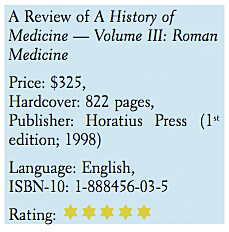
Also in this chapter Prioreschi discusses the widespread ancient practice of copying other writers’ works, not only in medical treatises but also in history and literature tracts, a practice that today we refer to as plagiarism. Prioreschi cites the Roman senator and historian Tacitus (A.D. 56–117) who had actually given us the answer. Tacitus explained, “We will follow the consensus of the authors, and when they disagree, we should record their versions under their names.”[25] Prioreschi notes that ancient authors felt it was superfluous to cite all the writers who were already in accord with one another; and when they all agree, their opinions became the “truth” and the property of all — i.e., intellectual property in the public domain as we would say today. Ancient writers also quoted others when the cited knowledge was not their own, as when the encyclopedists collected information from various sources. Pliny listed his sources at the beginning of his work but made no specific citations in the narrative.[25]
At the risk of repeating myself: I once again categorically recommend this tome without reservations, as a worthy sequel to Prioreschi’s second volume, Greek Medicine. This recommendation is made with high praise for its eloquence in relating periods of medical history that have been made prosaic by the pen of other writers. This third tome, A History of Medicine — Volume III: Roman Medicine by Dr. Plinio Prioreschi, belongs in every public library and in the book repertoire of every physician, medical historian, bioethicist, and student of medical ethics — all who are (or should be) interested in the history of medicine and medical ethics as it affects medical practice, as well as in the attainment of knowledge of medical history for its own sake.
REFERENCES
1. Prioreschi P. A History of Medicine: Vol. III: Roman Medicine. Omaha, Nebraska: Horatius Press; 1998.
2. Prioreschi P. A History of Medicine. Vol. 1: Primitive and Ancient Medicine. Omaha, Nebraska: Horatius Press; 1995. See my review of this book in Surg Neurol Int 2015;6:87. Available from: [Last accessed on 2015 June 20].
3. Prioreschi P. A History of Medicine: Vol. II: Greek Medicine. Omaha, Nebraska: Horatius Press; 1996. See my review of this book in Surg Neurol Int 2015;6:100. Available from: [Last accessed on 2015 June 20].
4. Prioreschi P. A History of Medicine: Vol. III: Roman Medicine. Omaha, Nebraska: Horatius Press; 1998. p. 26‑30.
5. Prioreschi P. A History of Medicine: Vol. III: Roman Medicine. Omaha, Nebraska: Horatius Press; 1998. p. 39‑41.
6. Prioreschi P. A History of Medicine: Vol. III: Roman Medicine. Omaha, Nebraska: Horatius Press; 1998. p. 73‑305, 196.
7. Prioreschi P. A History of Medicine: Vol. III: Roman Medicine. Omaha, Nebraska: Horatius Press; 1998. p. 307.
8. Prioreschi P. A History of Medicine: Vol. III: Roman Medicine. Omaha, Nebraska: Horatius Press; 1998. p. 307‑497.
9. Prioreschi P. A History of Medicine: Vol. III: Roman Medicine. Omaha, Nebraska: Horatius Press; 1998. p. 488‑91.
10. Prioreschi P. A History of Medicine: Vol. III: Roman Medicine. Omaha, Nebraska: Horatius Press; 1998. p. 482‑7.
11. Prioreschi P. A History of Medicine: Vol. III: Roman Medicine. Omaha, Nebraska: Horatius Press; 1998. p. 499‑533.
12. Prioreschi P. A History of Medicine: Vol. III: Roman Medicine. Omaha, Nebraska: Horatius Press; 1998. p. 532‑3.
13. Prioreschi P. A History of Medicine: Vol. III: Roman Medicine. Omaha, Nebraska: Horatius Press; 1998. p. xx-xxxvi.
14. Prioreschi P. A History of Medicine: Vol. III: Roman Medicine. Omaha, Nebraska: Horatius Press; 1998. p. 536‑67.
15. Prioreschi P. A History of Medicine: Vol. III: Roman Medicine. Omaha, Nebraska: Horatius Press; 1998. p. 624‑37.
16. Prioreschi P. A History of Medicine: Vol. III: Roman Medicine. Omaha, Nebraska: Horatius Press; 1998. p. 628‑9.
17. Prioreschi P. A History of Medicine: Vol. III: Roman Medicine. Omaha, Nebraska: Horatius Press; 1998. p. 569‑635.
18. Prioreschi P. A History of Medicine: Vol. III: Roman Medicine. Omaha, Nebraska: Horatius Press; 1998. p. 637‑56.
19. Prioreschi P. A History of Medicine: Vol. III: Roman Medicine. Omaha, Nebraska: Horatius Press; 1998. p. 657‑87.
20. Prioreschi P. A History of Medicine: Vol. III: Roman Medicine. Omaha, Nebraska: Horatius Press; 1998. p. 684‑7.
21. Prioreschi P. A History of Medicine: Vol. III: Roman Medicine. Omaha, Nebraska: Horatius Press; 1998. p. 689‑716.
22. Prioreschi P. A History of Medicine: Vol. III: Roman Medicine. Omaha, Nebraska: Horatius Press; 1998. p. 717‑56.
23. Prioreschi P. A History of Medicine: Vol. III: Roman Medicine. Omaha, Nebraska: Horatius Press; 1998. p. 719‑22.
24. Prioreschi P. A History of Medicine: Vol. III: Roman Medicine. Omaha, Nebraska: Horatius Press; 1998. p. 723‑40.
25. Prioreschi P. A History of Medicine: Vol. III: Roman Medicine. Omaha, Nebraska: Horatius Press; 1998. p. 746‑56.
Article written by: Dr. Miguel Faria
Miguel A. Faria, Jr., M.D. is Clinical Professor of Surgery (Neurosurgery, ret.) and Adjunct Professor of Medical History (ret.) Mercer University School of Medicine. He is an Associate Editor in Chief and a World Affairs Editor of Surgical Neurology International (SNI), and an Ex-member of the Injury Research Grant Review Committee of the Centers for Disease Control and Prevention (CDC). 2002-05; Former Editor-in-Chief of the Medical Sentinel (1996-2002), Editor Emeritus, the Association of American Physicians and Surgeons (AAPS); Author, Vandals at the Gates of Medicine (1995); Medical Warrior: Fighting Corporate Socialized Medicine (1997); and Cuba in Revolution: Escape From a Lost Paradise (2002).
This article was originally published in Surg Neurol Int 2015;6:104. This article can be cited as: Faria MA. Another medical journey to ancient Rome and Roman medicine with medical historian Plinio Prioreschi, MD, PhD. Surg Neurol Int 15-Jun-2015;6:104. Available from: https://surgicalneurologyint.com/surgicalint-articles/another-medical-journey-to-ancient-rome-and-roman-medicine-with-medical-historian-plinio-prioreschi-md-phd/
The photographs used to illustrate this book review came from a variety of sources and do not appear necessarily in the author’s book. They illustrate this article for the enjoyment of our readers.
Copyright ©2015 Miguel A. Faria, Jr., MD